July-August 2006
A Brother For Filipinos And The World
By Father Ramil R. Marcos
The late Pope John Paul II scheduled beatifications in Rome for 15 May 2005, Pentecost Sunday. He earned the reputation of being a saint-maker, beatifying and canonizing more holy men and women than all his predecessors. Some jeered at this practice, thinking that by increasingly adding to the roster of ‘blesseds’ and saints, he was trivializing the privilege once given strictly to very few.
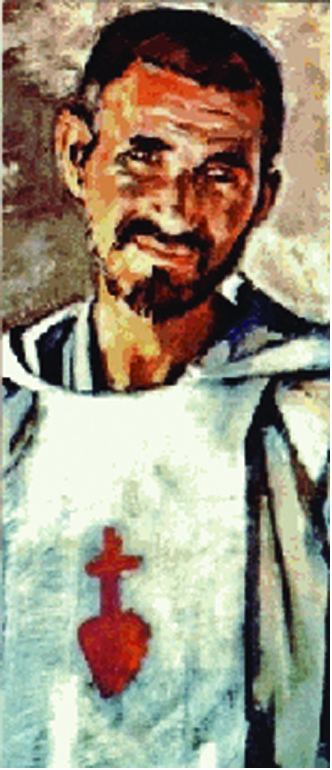
Charles de Foucauld
John Paul II, however, had a more pressing agenda. Naming new ‘blesseds’ and saints was for him an act of inspiring the world in the midst of today’s troubles, an infusion of a new sense of hope to the Church and the world struggling against the darkness and pain that constantly grab the imagination of the daily news – wars, corruption and deceit, terrorism, exploitation, dehumanization.
The pope believed that the world was and continues to be inhabited by witnesses to the Good News of Jesus Christ, people whose ardent love for God serves as flickers of light that illuminate the world. This optimistic attitude of John Paul II inspired us all, up to the ultimate moment of his own self-sacrifice. No wonder that now many Catholics and non-Catholics alike are advocating his canonization.
Because of the death of Pope John Paul the beatifications were postponed until 13 November. Among those beatified was a man simply known as Brother Charles – Charles de Foucauld, a Frenchman of noble birth. In hindsight it would seem on his deathbed Charles the pope (Karol or Charles was the pope’s baptismal name) introduced to the world Charles de Foucauld, the universal brother.
A man who cried the Gospel with his life
Who is this man, now ‘Blessed Charles,’ and how can he help us make meaning of our own strivings in faith?
Brother Charles of Jesus lived a classic story of conversion. Born in Strasbourg, France, on 15 September 1958, he was exposed to a tragic childhood with the early death of his parents, this and many other factors joined to destroy the seed of faith in his heart. By the time he was an adolescent, he was also an unbeliever.
Later he joined the French army and there proved to be a maverick. After quitting military service, he became an explorer, a feat that brought him to the Sahara where he daily observed the piety of the Muslims. This led him to consider his own relationship with God, which blossomed once again after he met a holy priest, Abbé Henri Huvelin, (‘Abbé’ is the title given to diocesan priests in France) who challenged him to go to confession. He wrote, ‘As soon as I believed there was a God, I understood I could do nothing else but live for him. My religious vocation dates from the same moment as my faith: God is so great. There is such a difference between God and everything that is not.’
With the ardor of a convert, Brother Charles sought to make up for lost time. He was totally enraptured by his new relationship with the Lord Jesus Christ that he sought the Lord everywhere. He traveled to Nazareth seeking to imitate the simplicity and obscurity of the early years of the Lord. He joined the Trappists, left them later, worked as a gardener for the Poor Clares in Nazareth and was later ordained a priest.
He went in 1901, with his bishop’s permission, to live as a hermit in Beni Abbès, Algeria. He later divided his time between there and Tamanrasset, in the southern Sahara, among the Touareg people. The move to Algeria carried with it a novelty – he went, not to make converts to Christianity among the Muslim population, but simply as a brother, like Jesus, living and sharing everything with those around him. Brother Charles learned the language of his neighbors, even writing a dictionary of their language. He shared their companionship and friendship. He carried them in his heart as he prayed in his hermitage.
The ransacking of his humble house by bandits on 1 December 1916 led to Brother Charles’ ultimate self-sacrifice. His place was looted and he was shot to death. As he fell to the ground, so also did Jesus in the Blessed Sacrament, whom he adored night and day, found lying close to his lifeless body.
He sought to be like Jesus
The marks of very human struggles, difficulties and joys punctuated the life of Brother Charles. It’s easy to feel an affinity with him. He experienced deep doubts in the face of problems. His lived restlessness was quenched only by the assuring words of the Gospel. There was the joy of discovery in his meeting with Jesus as he returned to his Catholic roots.
Today, it is clear that Brother Charles’ fascination with the life of Jesus in Nazareth can be the antidote to materialism and consumerism. His desire to become a ‘universal’ brother can lead us to examine our own tendencies to be distrustful of others and exclusive in our relationships. He lived and died in the desert, a place rich in biblical and early Christian interpretation – one that uncovers the reality of deep dependence on God alone, instead of on possessions, relationships and power.
Living in close proximity to Muslims, Brother Charles was a herald of the contemporary Church’s approach to other world religions; he was neither judgmental nor condemnatory – but affirming in the other religion what is good and beneficial to humanity. He sought to bring the love of Jesus to others by being their brother, earning their trust and extending his hand to those in need.
Brother Charles sought to be like Jesus, the Son of God who was a gift to the world as the Firstborn Son, the Brother of all. Charles wanted to be called a universal brother.
The Filipino Family of Brother Charles
Although Charles de Foucauld was certainly intended by John Paul II as a model for the universal Church, there was distinctive rejoicing here in the Philippines. In our country, we can find living traces of Brother Charles’ influence and presence through his ‘spiritual family.’
Though no one successfully imitated the rigid and disciplined life of Charles in his lifetime, he attracted followers after his death. As the Gospel testifies, when the grain of wheat falls into the ground and dies, only then does it bear much fruit. Soon after Brother Charles reflections and tragic death became known, men and women breathed life into his religious ideals.
Among those who follow his spirituality are two groups present in the Philippines for over twenty years, the Little Brothers of Jesus and the Little Sisters of Jesus. These are religious families of men and women who are contemplatives in the midst of the world. Unlike most religious brothers and sisters who operate schools, work as nurses and office administrators, and often move around in cars, these men and women choose to literally live the life of the poor.
They live in simple residences with simple and poor neighbors. Like their neighbors, they work manually for their daily support. The brothers have been employed as gardeners, vulcanizing attendants, street vendors; the sisters as laundry women, street-sweepers and factory workers.
In their simple daily routine, these heirs of Brother Charles find Jesus in their unbroken contact with the life-realities of their co-workers and neighbors. It is preaching the Gospel at its best, since witnessing is the most credible form of proclamation, more effective than mere words.
Priests too, both religious and diocesan, have found strength for their pastoral ministry through the example of Brother Charles. An international fraternity of priests called Jesus-Caritas is present in the Philippines in small groups called fraternities, from Luzon to Mindanao. Every fraternity regularly meets to adore the Blessed Sacrament, reflect on the Gospel and on the vicissitudes of priestly life and where the members can remind one another to live in simplicity, love for the poor and fidelity in service.
Truly, Brother Charles’ beatification is as much a local as an international affair. The spirit of this Frenchman is present in our country through men and women who have found an impetus to their Christian life through the observance of the great passion and the simple humility of one who found the ‘pearl of great price’ and did not keep it to himself.
Conclusion
Now that our beloved pontiff John Paul II has been laid to rest, his legacy of discovering the positive in our world continues. We have much to thank him for infecting the Church with the conviction that sainthood, official or unofficial, is a living reality even today. The world teems with the cogent testimony of lives lived in closeness to the person and the power of the Lord Jesus Christ. One such person is Blessed Charles de Foucauld, whose spirit is at home with Filipino Christianity.
Thanks to our father Charles (Karol) Wojtyla for sharing with us our brother, Charles of Jesus.
The author is Vicar General of the Diocese of Pasig and a member of Jesus-Caritas Fraternity of Priests.
Cardinal Rosales And Faith & Light
By Maggie Rivera
The author is the National Coordinator of Faith and Light Philippines. Faith and Light is a movement of communities made up of people with an intellectual disability, surrounded by family members and friends, who meet at least once a month to pray, share and celebrate the friendship of Jesus. There are twelve F&L communities in Metro Manila. www.foietlumiere.org is the website of Faith and Light International.
Faith and Light Philippines (F&L) is very blessed in having Cardinal Gaudencio Rosales, Archbishop of Manila, as its reference bishop. In spite of his very busy schedule, he finds time for us. He attends some of our meetings to be with and get to know the members of the community.
Even before becoming our reference bishop, Cardinal Rosales was close to people with mental disabilities. One of his friends is Bololoy, a member of Sampaguita F&L in Mandaluyong. He is about 50 and has Down Syndrome. For years, whenever the Cardinal would visit the Little Sisters of Jesus in Mandaluyong, he’d meet Bololoy, also a friend of the Little Sisters. Last September, they met again on the annual F&L pilgrimage that takes place around the Birthday of Mary. They were able to talk and share ‘high fives.’ When Bololoy was performing during the program I overheard Archbishop Rosales telling a priest beside him, ‘Yan si Bololoy, kaibigan ko yan.’
Maybe the Cardinal also told him about the time he went for lunch to the Little Sisters. Bololoy usually eats with the Sisters, as he considers himself a member of their community, and has his own fixed place at the table. When he saw that the Archbishop had sat in this place he whispered to him, ‘Monsignor, your driver wants to talk to you outside.’ When the Archbishop came back he could only laugh when he realized that Bololoy had taken his place. But there was room for everyone.
As Bishop of Malaybalay, Cardinal Rosales attended a retreat in Cebu in October 1991 given by Jean Vanier, the Canadian layman who founded Faith and Light with Marie-Hélène Mathieu.
Our new cardinal agreed to be F&L Philippines’ reference bishop in April 2002. As such he is our overall spiritual shepherd, inspiring all our members, especially our chaplains in their important role, and encouraging other priests to join. He is also called to help facilitate the integration of persons with mental disabilities, with their family members and friends, into the wider Catholic community.
Since 2002 Cardinal Rosales has attended our annual pilgrimage in honor of the Blessed Mother and has been the main celebrant at the Mass./st1:State> Those in 2002, 2003 and 2004 took place in Sto Tomas, Taal and Sto Tomas again, all in Batangas, Archdiocese of Lipa. As archbishop there from 1992 till 2003, Archbishop Rosales helped choose these venues and got involved in the preparation so that the people of the archdiocese would become more familiar with F&L. Though already Archbishop of Manila he still went to Sto Tomas in September 2004. As Archbishop of Manila he facilitated our having our pilgrimage last year in Our Lady of Guadalupe Minor Seminary, Makati City.. As always, he found time to eat and mingle with the members of the community, particularly with our special friends and their parents.
Archbishop Rosales met up again with Jean Vanier in Lipa in May 2004 when he gave a retreat for Faith and Light, L’Arche, and other friends of the community.
In October 2004 and October 2005 our reference bishop invited the F&L National Council to his home at the Arzobispado, Manila, where he celebrated Mass with us, had lunch with us and spent the afternoon with us.
Cardinal Rosales is much more than a ‘reference’ bishop. His baptismal name, Gaudencio, comes from the Latin word gaudium, meaning ‘joy,’ ‘delight,’ ‘happiness.’ Particularly to his i style="mso-bidi-font-style:normal">mga kababayan l like Bololoy, he reflects the truth of God’s word in Psalm 149, ‘God takes delight in his people.’
You may email Maggie Rivera at maggi0866@yahoo.com or fnlphilippines@yahoo.com
Homily At Funeral Of Fr Nery Lito Satur
By Bishop Gaudencio Rosales of Malaybalay
Father Nery Lito Satur, the young parish priest of Guinayoran, Valencia, Bukidnon, in the Diocese of Malaybalay, was murdered on 14 October 1991 in an ambush. It is believed that illegal loggers were behind this. He was one of 45 priests, deacons and local citizens deputized as forest officers by the Department of Environment and Resources to arrest illegal loggers. The then Bishop of Malaybalay, Gaudencio Rosales gave this homily at the funeral of Father Nery.
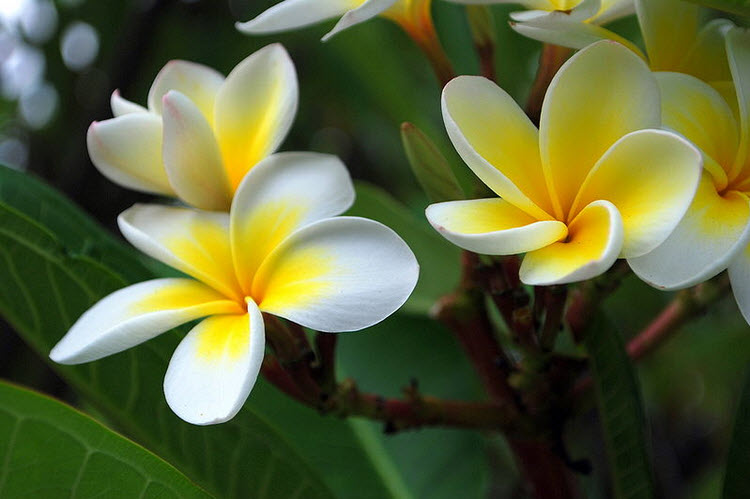
I feel bad, not because Fr Nerly Lito Satur gave up his life for the cause of the Gospel; this is God’s will. But I am very angry because the devil is still so active in our local church. The worst part is that the devil has friends and accomplices here! Evil struck again! This time to pluck the life of a very young priest given to the crusade of keeping integrity of nature to make farm livelihood more productive for the poor . . .
There was a time when men in uniform would strongly accuse priests as radicals, fomenting violence and rebellion.
I say this loud and clear that not one of our priests, not one of our religious, not one of our church workers in this Local Church following the paths that our Apostolic Vision draws us to, subscribes to violence, encourages it, motivates it or even befriends it as a means to integral salvation in and through Jesus. Anyone who voices the contrary is not speaking for the Church! Above all he is not speaking for Christ.
Father Nery defended the ecological balance, he actually upheld the Government’s Total Logging Ban in the province. And he did this not for any political reason, but in an honest belief that the forests are for the future life of the poor in the country.
Now that Father Nery is dead we demand justice for him and the Church that he served so well. And the government authorities whose obligation it is to secure what is just, should better work this out soon for Father Nery . . .
Thank you brother priests, for showing your love and brotherhood with Nery; thank you for the time, trust and love you shared with him. Thank you for accepting the price of the love we know in Jesus. We can never inflict harm, but we are always ready to be harmed while we are giving Christ to the people. Victimhood is at the core of poverty which brings us to the very heart of His Kingdom – Love.
In 1997, under the name ‘Dency B. Rosales’ the Cardinal wrote Fr Nery Satur and the Church He Died For (Claretian Publications).
How God Sees Creation
God looked at everything he had made, and he found it very good. (Genesis 1:31)
Do we see it the same way?
The pastor must be inspired by Christ’s holy zeal: for him it is not a matter of indifference that so many people are living in the desert. And there are so many kinds of desert. There is the desert of poverty, the desert of hunger and thirst, the desert of abandonment, of loneliness, of destroyed love. There is the desert of God’s darkness, the emptiness of souls no longer aware of their dignity or the goal of human life. The external deserts in the world are growing, because the internal deserts have become so vast. Therefore the earth’s treasures no longer serve to build God’s garden for all to live in, but they have been made to serve the powers of exploitation and destruction. The Church as a whole and all her Pastors, like Christ, must set out to lead people out of the desert, towards the place of life, towards friendship with the Son of God, towards the One who gives us life, and life in abundance. (Pope Benedict XVI, homily at inaugural Mass, 24 April 2005).
Misadventure In PNG
By Sister Nellie L. Margate, OND
I still smile when I remember the reaction of the policemen seeing the contents of my bilum, a traditional PNG string bag, when I emptied it on top of the table in front of them all. It was a sunny Sunday morning. I and one of our sisters attended Mass at the University of Papua New Guinea. We were both in our best Sunday habit and after Mass decided to go to the parking lot between the PNG parliament and PNG Museum for my companion to hone her reversing and parallel parking skills before she’d start driving on the main roads.
Deceiving smile
I was showing her how to do parallel parking when a young man of about 18 with a broad smile approached us. I greeted and talked to him in Pidgin and he seemed very friendly when all of a sudden he grabbed my bilum and ran across the open space between the parliament and the nearby Waigani flea market. On impulse, I threw my shoes at him and ran after him barefooted. Some people who saw us just stood and watched without doing anything, but a young fellow who was with us outran me as both of us tried to catch the rascal, as anybody who disrupts peace and harmony in the community is known.
Exhausted victim
I knew that I couldn’t catch up with the two fellows so, panting and gasping for breath, I went back to the parking area. It was then that I realized I could hardly walk because the place where I’d been running was littered with thorns from burnt bushes. Limping and angry with the onlookers, on whom I vented my frustration, I reached the place where the car had been. But now it was nowhere to be seen. After some time, the car was back with the PNG Museum guard as driver.
He had seen what had happened and, being a former ‘rascal’ himself, knew where that fellow would hide. He drove the car towards Waigani market, the other Sister still transfixed in it. A ‘hide and seek’ between the ‘rascal’ and the guard ensued at the market. They found him and after a struggle apprehended him and brought him to the Waigani police station.
What’s inside my bilum
They then came back for me to identify and claim my bilum. The police asked me if it belonged to me. I said it did. When they asked to check the contents, I emptied the bilum on the table in front of the policemen, the ‘rascal’ and all the people present in the station at the time. In it I had two mint candies, a bunch of keys, a borrowed book, a pair of sunglasses, rosary beads and K0.29, the equivalent of P5.00. (See www.bankpng.gov.pg/kinatoea/index.htm for information on PNG money). The people there could hardly suppress their amusement. I, too, smiled and offered the candies to the ‘rascal’ but felt a bit embarrassed at the little amount of money I had with me.
Unmindful of the danger
After some time, the policemen realized that the ‘rascal’ was a long-wanted fellow whom they had been looking for, for various offences like stealing, breaking in and several others. Monsignor Peter Kurongku, then Archbishop of Port Moresby, wasn’t happy with me. He told me that I could have been killed by ‘rascals’ who don't respect life, especially when cornered. On my part I could only say that indeed, God was with me.
Pareng Rufus
By Gaudencio B. Cardinal Rosales
The author, after ten years as Archbishop of Lipa, his native diocese, was appointed Archbishop of Manila by Pope John Paul II on 15 September 2003 and created cardinal by Pope Benedict XVI on 24 March this year.
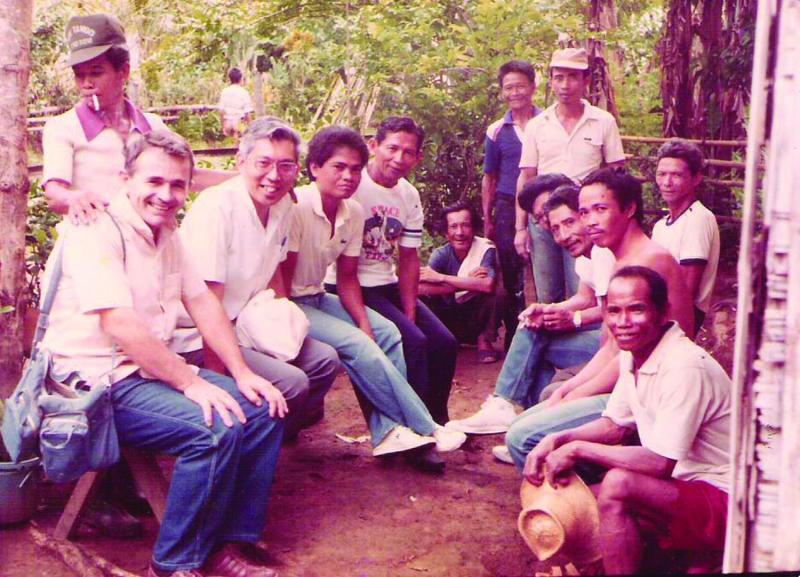
A young Bishop Rosales, seated, second from left, with Fr Bernard Jagueneau of the Little Brothers of Jesus. Far left, another close friend of Father Rufus
I first met Father Rufus Halley in the mid-1970s when I was appointed auxiliary bishop in Manila with responsibility for Rizal Province, the area that became the Diocese of Antipolo in 1983. The Columbans had been working in parishes there since before the War. Father Rufus was in Jalajala at the time. Father Feliciano Manalili, a diocesan priest, introduced me to him. Father Manalili is now a Trappist monk in Mepkin Abbey, South Carolina, USA, www.mepkinabbey.org , where he is prior.
New friend
At first I knew Father Rufus in a formal way, as one of the parish priests under my jurisdiction. But I gradually began to know this man with an open personality and a wonderful sense of humor as a person. On one occasion he invited me to a barrio in his parish that was 45 minutes by boat from thecentro. He had forewarned me that this would be a different kind of pastoral visit. We set off in the afternoon. The house where we stayed was on a duck farm and some of the birds were waddling around the house. There was no electricity. After dinner we walked around the village. I saw the people at their usual occupations that included drinking and gambling games such as bingo. Father Rufus introduced me as ‘my friend from Manila,’ which wasn’t untrue, as we were in the Archdiocese of Manila.
Back at the house we chatted for a long time and prayed together. We decided we’d celebrate Mass the next day back at the centro. We slept on the floor. As we were leaving next morning people came to see us off and it was only then that their parish priest told them that I was the area bishop. Though there was some embarrassment, especially among those who were members of Church organizations, there was a lot of laughter at the realization that the bishop had met them as they really were.
Tagalog speaking Irishman
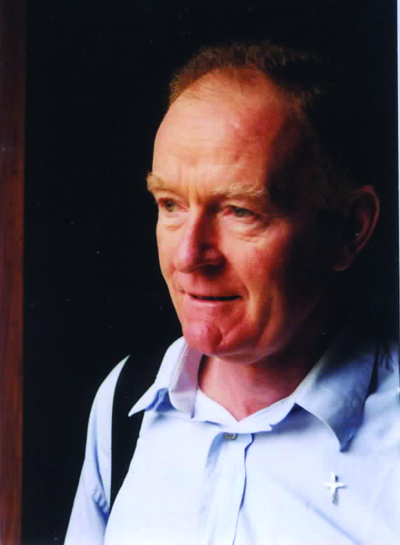
'My friend Rufus wanted not only to know the faith and culture of Muslims but to "befriend the culture of our brother Muslims". More than that, he wanted to understand the culture of the Maranaos.'
By this time Father Rufus and I were close friends and I called him ‘Pareng Rufus’ and he called me ‘Pareng Dency.’ I felt free to drop in on him any time and to go through the back door of hisconvento. Sometimes I wouldn’t find him in the office or upstairs and would then realize that, despite his red hair and blue eyes, I had passed him in the kitchen, where he was chatting with the staff. (His baptismal name was Michael but his parents always called him ‘Rufus’ because of his red hair). What threw me was that I’d hear only pure Tagalog while walking through the kitchen. My Irish friend spoke the language perfectly.
Another trademark of Father Rufus was his bakya. I learned from the late Father Patrick Ronan, then parish priest in Morong, that Father Rufus came from a privileged background. That was a revelation to me, as I had always been struck by the simplicity I saw in his life. Father Ronan, another Irish missionary with a great sense of humor and known to his fellow Columbans as ‘Pops’, had spent time in jail in China after the Communist takeover in 1949.
Around 1980 Father Rufus felt called by God to leave the security of living in an overwhelmingly Catholic community to work in the new Prelature of Marawi, which includes all of Lanao del Sur and part of Lanao del Norte, where 95 percent of the people are Muslims. He was very aware of the long history of tension and occasional outright conflict between Christians and Muslims. He also became fluent in two other languages, Maranao, spoken by the Muslims in the area, and Cebuano, spoken by the Christians.
His kind of dialogueo
I too moved to Mindanao, becoming Coadjutor Bishop of Malaybalay in 1982 and succeeding Bishop Francisco Claver SJ in 1984. On one occasion, after spending about a week on retreat in the Benedictine Monastery of the Transfiguration in Malaybalay, Pareng Rufus came to spend a night at my place. He spoke of a ‘brother Muslim’ whom he loved very much and told me that he had been hired to work in a store in the market in Malabang, Lanao del Sur. ‘Why?’ I asked him. ‘This is my kind of dialogue,’ he told me. He was pushing Christian-Muslim dialogue to the limit. When the late Bishop Bienvenido Tudtud, first bishop of the then Prelature of Iligan, which covered the two Lanao provinces, told Pope Paul VI of the conflict there and of his vision of a ‘dialogue of life’ between the two communities, the Pope encouraged him to the extent of dividing the prelature and transferring him to Marawi. Bishop Tudtud died tragically in a plane crash in 1987.
Male dominated Maranaos
My friend Rufus wanted not only to know the faith and culture of Muslims but to ‘befriend the culture of our brother Muslims.’ More than that, he wanted to understand the culture of the Maranaos. This involved trying to understand aspects of that culture that went against his own warm nature and that didn’t seem to be in harmony with the Gospel. For example, he noticed that among Maranao men it wasn’t seen as proper to show any public signs of softness, even if a child of theirs was hurt. He noticed how stiff Maranao men are in their dances which many Filipinos are familiar with. Men sometimes carry a kris as a sign of power. He was well aware that many men, Christian and Muslim, carry a gun for the same reason, and not only in Lanao. He asked himself if there were any areas of tenderness in the macho culture of the Maranaos and stressed the importance of trying to find ways in which the Gospel could enter into dialogue with that culture.
Pareng Rufus was really educating me that night.
Who inspired himo
I knew of the intensity with which Father Rufus lived his own Christian faith, how he began each day with an hour of adoration before the Blessed Sacrament, the centrality of the Mass in his life. A big influence on him was the life of Charles de Foucauld, 1858-1916, beatified last November. This Frenchman was also from a privileged background. Unlike Pareng Rufus, he lost his Catholic faith and became a notorious playboy before re-discovering it, partly through the example of Muslims living in North Africa. He spent many years as a priest living among the poorest Muslims in a remote corner of the Sahara, pioneering Christian-Muslim dialogue by discovering himself as the Little Brother of Jesus in the Blessed Sacrament and as the Little Brother of the Muslims who came knocking at his hermitage door.
Death of a peacemaker
On 1 December 1916 Charles de Foucauld died at the hands of a young gunman outside his hermitage and on 28 September 2001 Pareng Rufus died at the hands of gunmen who ambushed him as he was riding on his motorcycle from a meeting of Muslim and Christian leaders in Balabagan to his parish in Malabang. The local people, both Christian and Muslim, mourned for him deeply. The grief of the Muslims was all the greater because the men who murdered my Pareng Rufus happened to be Muslims. This great missionary priest brought both communities together in their shared grief for a man of God, a true follower of Jesus Christ.
Pontifical Council For Interreligious Dialogue
MESSAGE FOR THE END OF RAMADAN
‘Id al-Fitr 1426 AH / 2005 AD
Continuing of the Path of Dialogue
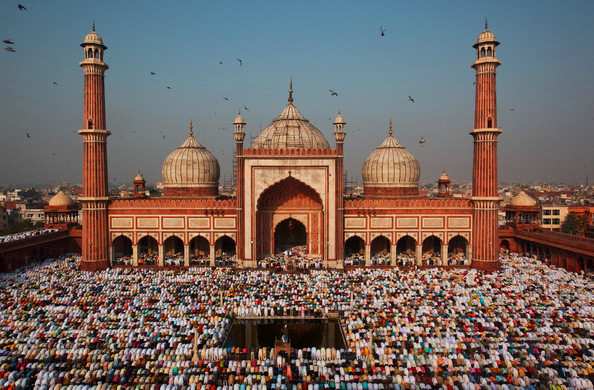
Dear Friends,
1. As ‘Id al-Fitr comes round again, at the close of the month of Ramadan, I wish to offer to all of you, in whatever part of the world you may be, my very best wishes for a Happy Feast.
2. It has become a tradition for the Pontifical Council for Interreligious Dialogue to send a message to our Muslim brothers and sisters on the occasion of the end of Ramadan. The message has usually been signed by the president of the Pontifical Council. In 1991, on account of the first Gulf War, the good-will message was signed by His Holiness Pope John Paul II. He wrote about the need for ‘a sincere, profound and constant dialogue between believing Catholics and believing Muslims, from which there can arise a strengthened mutual knowledge and trust.’ These words are surely still relevant today.
3. On 2 April of this year Pope John Paul II completed his earthly life. Many Muslims around the world, with Catholics and other Christians, followed closely the news of the Pope's last illness and his death, and official delegations of Muslims, political and religious leaders from many countries, attended his funeral in Saint Peter's Square. Many had appreciated deeply the Pope's constant efforts on behalf of peace. A Muslim journalist who had had occasion to meet personally with Pope John Paul II wrote: ‘I am not exaggerating when I say that the death of Pope John Paul II has been a great loss for the Catholic Church and for Christians in general, and also for Christian-Muslim relations in particular. There can be no compensation for this loss other than to follow in his footsteps and to continue in the way that he has traced out with the faith and courage of Assisi in 1986, Assisi where lie the remains of Saint Francis, pioneer among Catholics of Christian-Muslim dialogue.’
4. It was faith in God and confidence in humanity that impelled the late Pope to engage in dialogue. He constantly reached out to brothers and sisters of all religions with respect and a desire for collaboration, as had been encouraged by the Second Vatican Council in its Declaration Nostra aetate of which the fortieth anniversary occurs this year. His commitment in this regard was actually rooted in the Gospel, following the example of the Lord Jesus who showed his love and respect for each person, even for those who did not belong to his own people.
5. Following the teaching of the Vatican Council II and continuing on the path taken by Pope John Paul II, His Holiness Pope Benedict XVI, when receiving the representatives of other religions who attended the celebration for the beginning of his Pontificate, stated: ‘I am particularly grateful for the presence in our midst of members of the Muslim community, and I express my appreciation for the growth of dialogue between Muslims and Christians, both at the local and international levels. I assure you that the Church wants to continue building bridges of friendship with followers of all religions, in order to seek the true good of every person and of society as a whole.’ Then, making reference to the conflicts, violence and wars present in our world, the Pope emphasized that it is the duty of everyone, especially those who profess to belong to a religious tradition, to work for peace, and that ‘our efforts to come together and foster dialogue are a valuable contribution to building peace on solid foundations.’ Pope Benedict XVI concluded by saying: ‘It is therefore imperative to engage in sincere and authentic dialogue, built on respect for the dignity of every human person, created, as we Christians firmly believe, in the image and likeness of God’ (cf. Gen. 1: 26-27) (L’Osservatore Romano, 26 April 2005).
6. Encouraged by these words of the Pope, it is for us to strengthen our engagement in building up good relations among people of different religions, to promote cultural dialogue and to work together for greater justice and enduring peace. Let us, as Christians and Muslims, show that we can live together in true fraternity, striving always to do the will of Merciful God who created humanity to be one family.
Once more I express to you my warmest greetings.
H.E. Archbishop Michael L. Fitzgerald
President
This year Ramadan is observed from 24 September to 22 October. The beginning is based on the visibility of the lunar crescent and could be a day or two earlier or later than estimated. Islamic Year 1427 H began on 31 January. The next year starts on 20 January AD 2007.
Archbishop Fitzgerald is now Apostolic Nuncio to Egypt and Delegate to the Organization of the League of Arab States.
Presence Beyond Boundaries
By Joy Ampiloquio
This reflection is born from the writer’s experience of being in a multi-religious work context in Taiwan and journeying with young people who are searching for meaning in life. In many instances, students share that they feel so at home and able to open their hearts. The writer also has some Buddhist friends who marvel at the fact that a Catholic is willing to be nourished by their practice of meditation.
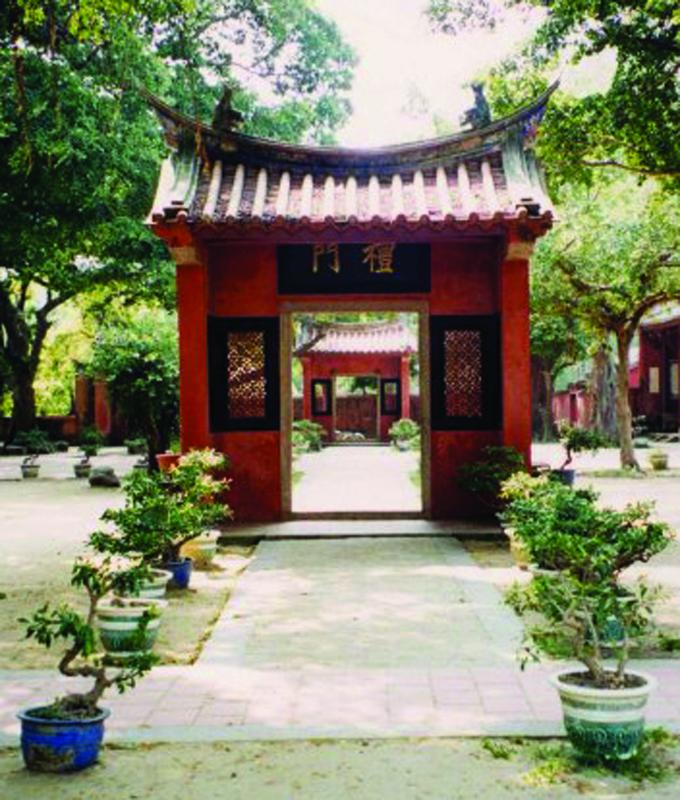
My vocation to the Teresian Association(www.institucionteresiana.org/asp_en/index.asp) is a call to live Jesus’ mission in a world of diverse and complex realities. The Association carries its mission in the style desired by St Pedro Poveda: ‘a transforming presence in the world’s realities, attentive to the signs of the times.’ The fulfillment of the mission is a challenge to be a committed presence, like leaven, through personal witness and through carrying out one’s profession. It is our mission as followers of Christ to share His values and bring about change in persons and situations.
Wealth of cultures
If you are living in Asia, particularly in India, Japan and Taiwan, you are in the midst of people of different religions with a long history and wealth of tradition. If you are in Israel or Jordan, you are mixing with other Christians, mostly Catholic and Orthodox, and with Jews and Muslims. If you are in the Philippines, you are part of a large majority of Catholics, with small minority of other Christians and believers of other faiths. Praise God ‘for the wealth of cultures, languages, traditions and religious sensibilities of this continent’ (Ecclesia in Asia, 50, John Paul II, 1999). In today’s world it is imperative that we open our minds and expand our vision towards the challenges brought about by its multi-faith and multi-cultural reality.
A friend of sinners
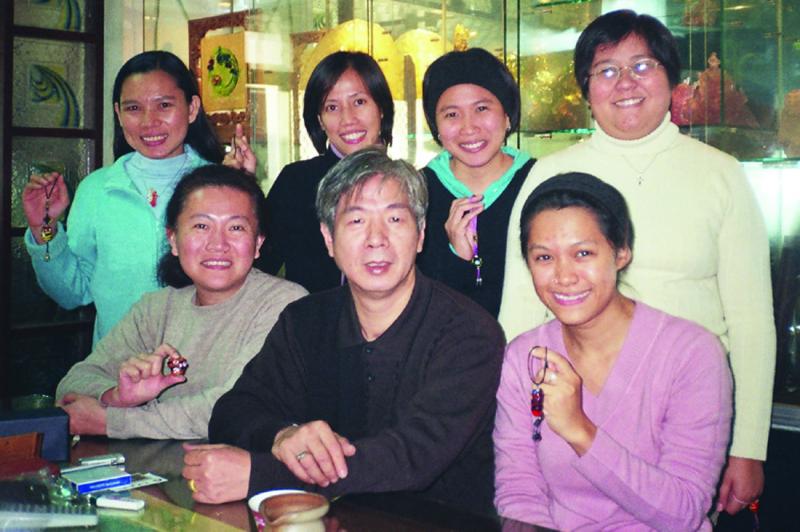
Being in Asia entails a sharing of a witnessing presence beyond boundaries. Our presence is rooted in the experience of God which flows from a living faith. Jesus’ mission was making people aware of God’s presence and to make this presence effective in their lives. He mixed with the ordinary citizens of his time, was a friend of sinners, tax collectors, the sick and even children. By accepting them, he brought them acceptance not only in the eyes of human beings but also the assurance that they were acceptable to God as well.
To make a difference
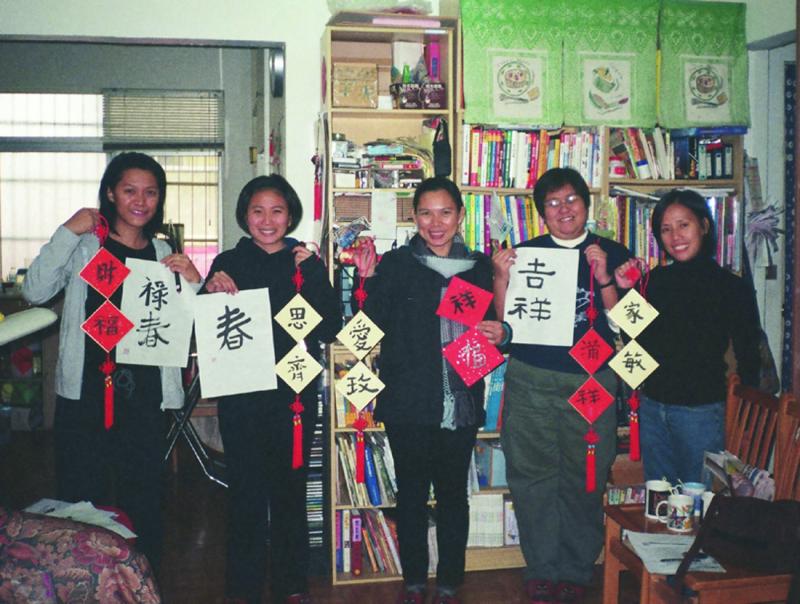
We, as followers of Jesus, begin with the step of making ourselves fully present to the context where we are; entering into dialogue with others with an attitude of openness and humility; learning, listening and loving and being a transforming presence. St Pedro Poveda said that the mission of the Teresian Association’s members – indeed of all Christians -- is ‘to season the tasteless wherever they go, in places where they live, among the persons with whom they come in contact; to make life pleasant, virtue fervent, penance joyful and suffering a consolation. They ought to work in such a manner, talk in such a way, always act with such good spirit, treat others with such friendliness, comfort them generously and bring to their spirit such conviction that their presence seasons their entire life.’ We are to emanate an attitude of ‘complementarity and harmony,’ as Jacob Kavunkal SVD puts it(www.sedos.org/english/JacobSVD.htm). We enter into inter-cultural and inter-religious dialogue, which is a ‘new way of our being Christian’ not only in Asia but in every part of the world. We should know how to blend, get out from our comfort zones and allow ourselves to dissolve like salt to give flavor and make a difference to whoever we meet, regardless of race, color and creed, wherever we are. Our own faith must not stop nor limit us in relating with persons of other faiths or those with no faith. We should rathertrust, communicate and collaborate with them.
Essence of prayer
Jesus’ own mission sprang from a relationship with the Father. In his ministry, he would always withdraw to a quiet place and pray. In Asia, genuinely religious person readily wins respect and a following. Prayer, fasting and various forms of asceticism are held in high regard. Renunciation, detachment, humility, simplicity and silence are considered great values by all religions. A life of prayer is essential, as it is a source of strength and opens the way for communication with God and others. To offer a presence without boundaries, one must be determined to grow and persevere in prayer. One must be able to achieve a certain interior purity, thus, there is mindfulness of the exterior. We ‘need to pray day and night that the Lord will strengthen the purpose in our hearts,’ as St Pedro Poveda wrote in 1920. The purpose we have is to offer to the world a presence without boundaries, a presence that transforms!
Timely Advice
by Nicholas Murray
It is amazing how a potentially disruptive incident can result in a learning experience both for students and teacher alike. My enlightenment came in an Oral English class towards the end of last semester. It came through the ringing of the ubiquitous mobile phone. Because of its disruptive effect I had previously banned it from my classes. Little did I realize then that one day it would bring me a timely message.
David was a twenty four-year-old student, one of four male students in a Freshman class of thirty. Most of his fellow students were in the 20 or 21 age bracket and I often wondered how he finished up in that class at all. Having been graded on the basis of their entrance exam, this was a bright, alert and enthusiastic class, all of which qualities seemed to have bypassed David.
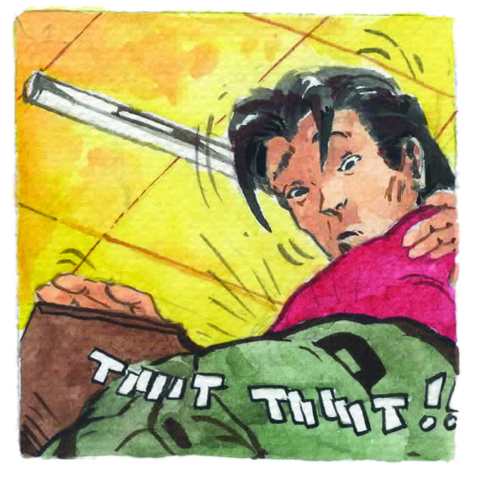
Still he was a pleasant and likeable character when awake! He had studied for a few years in another institute and unfortunately had imported with him some annoying habits, such as arriving late for class and then proceeding to drop off to sleep. It was rumoured that this was the result of long hours spent in the Internet bar. David himself, however, attributed it to his having a part-time job and thus being worn out from the exertion. His younger but more enthusiastic classmates were not impressed and Cynthia, the class monitor, took it upon herself on a number of occasions to remind him that his conduct was unacceptable and not appreciated. As a teacher, I had also made my feelings known on the matter but had eventually come to the conclusion that it was better to let sleeping dogs lie!
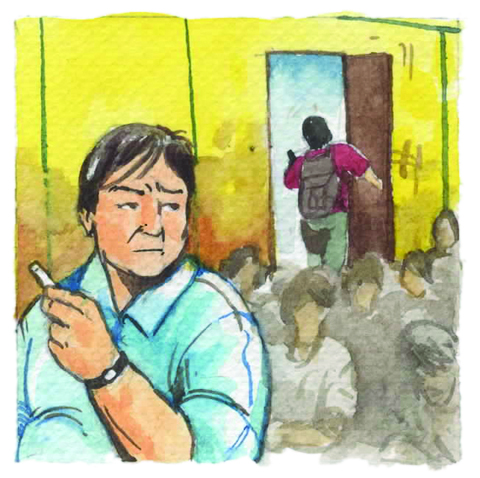
Since our class was an Oral English class, the emphasis was on comprehension and the expression of ideas. To highlight this focus I insisted on giving the class the rather prestigious name of Proficiency in English Communication. Specific topics were selected for discussion each day and students were encouraged to express their views and insights. This is something that does not come easy to Chinese students in any subject, but gradually it catches on and one is often treated to some inspiring insights and ideas. Usually a daily handout relevant to the topic being discussed triggers this off.
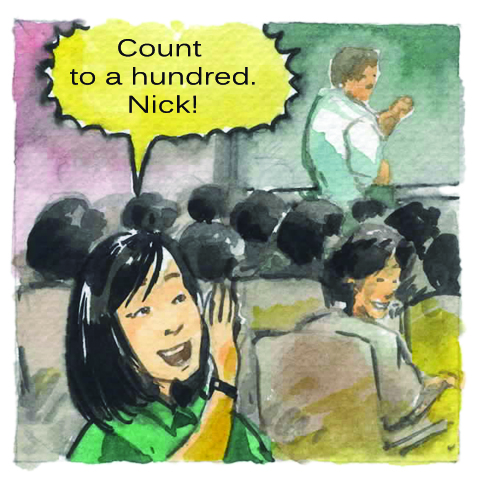
On the day in question David arrived late and, after a due period of settling, promptly fell asleep. The handout for the day was entitled Things to Remember and began with the advice: ‘Before you say anything to anyone, ask yourself is it true? Is it kind? Is it necessary?’ Further down the list we read: ‘Forget about counting to 10. Count to 1,000 before doing or saying anything that could make matters worse.’ Count to 10 was a completely new expression for my students so I explained it in some detail, seemingly rather successfully as can be seen from later developments.
Just as I finished my explanation, as if on cue, David’s cell phone rang. Being in a deep sleep at the time he did not realize what was happening. A judicious nudge from his seatmate brought him to life, and he concluded he was in deep trouble. He grabbed the phone from his pocket and bolted for the door, even before I had time to react. Then from the other side of the classroom came the kind and plaintive voice of Cynthia, ‘Count to a hundred, Nick!’ Kind and timely advice no doubt.
Why I Am A Missionary
by Ariel Presbitero
Ariel Presbitero went to Brazil as a Columban lay missionary in 1992 and after six years there moved to Peru. He is now living in the Philippines.
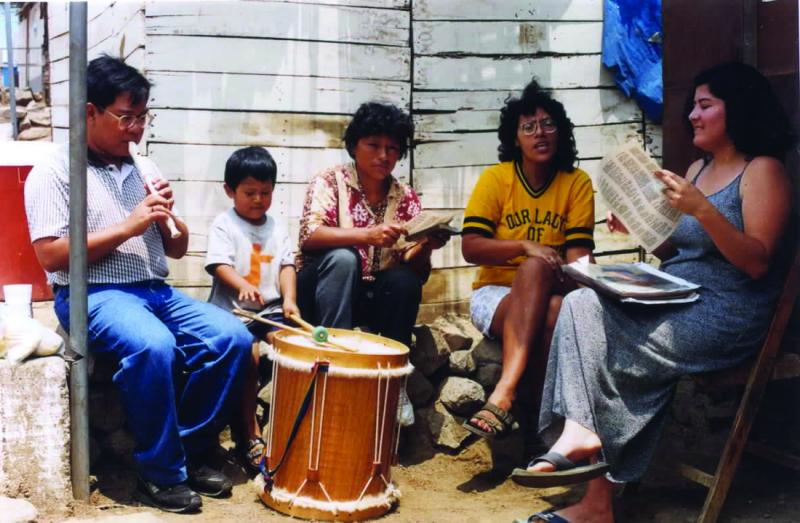
Ariel playing the flute
with friends in Peru
What really attracted me to join the lay missionary program of the Missionary Society of St Columban was its conviction and commitment to the same mission that Jesus started 2,000 years ago – building the kingdom. Disciples and apostles of Jesus have to take a definite perspective on why they are missionaries.
Being with the poor
Fr Gustavo Gutierrez OP says that to follow the theological principle of preferential option for the poor, three elements are very important. First, go where the poor are. What makes some people alienated with this conviction is that they don't live and experience what it is like to be poor because they don't physically go there. They become prisoners of their own theoretical knowledge of the poor and of not ‘being’ with the poor. Therefore, it's essential to go where poverty is most felt. Second, one has to think from the perspective of the poor. It’s not enough to be with the poor, but to try and grasp how the poor think and react to the pressures around them. Third is spirituality. It's the heart of Jesus' message to humanity. That is to live with the conviction and personally experience the spirit of the poor.
How to be satisfied
Keeping all this in mind, I opened up myself to the same option that Jesus opted for. It became a real challenge for me to adapt to and become assimilated in the reality of the poor. The challenge to be present among them was indeed a demanding motivation. In St Matthew’s Gospel, Jesus started preaching to the people and giving them hope, ‘Blessed are those who have the spirit of the poor, for theirs is the kingdom of heaven; blessed are those who hunger and thirst for justice, for they shall be satisfied.’ The marginalized, oppressed, discriminated against, isolated, restless, dying, fearful and abandoned are the preferred people of Jesus.
As missionaries, we are also called to give hope and to challenge the emerging social ills that oppress the freedom of our people.
One meaningful journey
Finishing my six years in Peru as a long-term lay missionary has brought me a sense of inner joy to share what it’s like to be part of the greater mission of God for the world. I feel blessed to have people who support and share the same journey with me to make this service very meaningful. It's worth taking the risk. I was able to capture the real essence of mission -- how we allow the people, especially the poor, to transform us and give real meaning to why we live and exist.
World Environment Day
By Father Sean McDonagh SSC
Fr Sean McDonagh, a Columban missionary priest who spent over 20 years working in the Philippines, reflects on the fact that few allude to the teachings of the late Pope John Paul II on the environment. The author, based in Ireland, has written extensively on ecology and religion. His latest book is The Death of Life: The Horror of Extinction, (Columba 2004). Claretian Communications Philippines, www.bible.claret.org , have published a number of his books.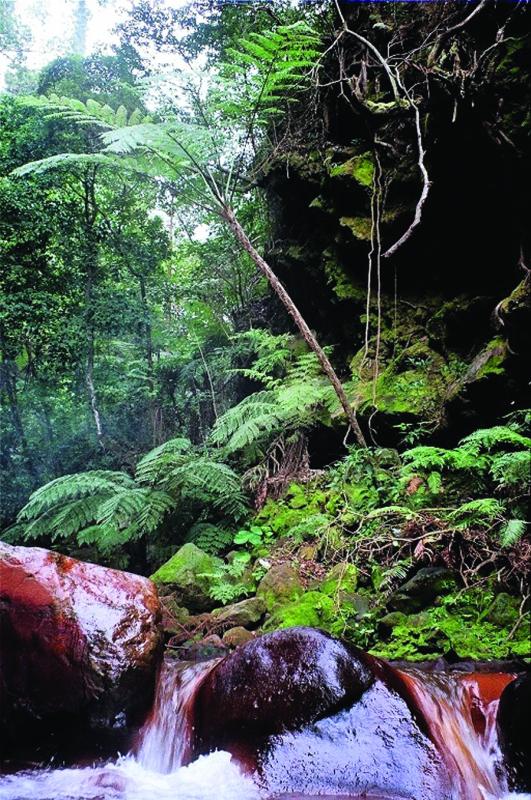
Every year on 5 June the United Nations Environment Programme (UNEP) organizes World Environment Day, www.unep.org/wed/2006/english . This is an opportunity for everyone, especially Catholics, to thank God for the beauty and bounty of creation and to reflect on what is happening to God’s creation both globally and in their own parish and diocese. In the wake of the death and funeral of Pope John Paul II last year many commentators reflected on how he promoted social justice and human rights in different parts of the world. Few alluded to his teaching on the environment. True, the environment was not at the top of his agenda but he did have insightful things to say which have been totally overlooked.

Simplicity, moderation and discipline
In Peace with God the Creator, Peace with all Creation, which he published on 1 January 1990 he wrote: Christians, in particular, know that their responsibility within creation and their duty towards God and the Creator are an essential part of their faith. (No 15). In the same document he suggested that modern society will find no solution to the ecological problems unless it takes a serious look at its lifestyle. He believed that simplicity, moderation and discipline, as well as a spirit of sacrifice, must become part of everyday life, lest all suffer the negative consequence of the careless habits of a few.
On 17 January 2001 at a general audience his environmental critique was much more forthright and ominous: Unfortunately, if we scan the regions of our planet, we immediately see that humanity has disappointed God's expectations. Man, especially in our time, has without hesitation devastated wooded plains and valleys, polluted waters, disfigured the earth's habitat, made the air unbreathable, disturbed the hydrogeological and atmospheric systems, turned luxuriant areas into deserts and undertaken forms of unrestrained industrialization, degrading that ‘flowerbed’ - to use an image from Dante Alighieri - which is the earth, our dwelling-place. We must therefore encourage and support the ‘ecological conversion’ which in recent decades has made humanity more sensitive to the catastrophe to which it has been heading.
Unfortunately, this call to conversion has, for the most part, fallen on deaf ears, because people in vital positions in politics, economics, the media and religion regularly fail to assess the ecological impact of their activities.
One might even be tempted to dismiss this speech as having more to do with apocalyptic religious language that with science but for the fact that it is substantiated by the recent Millennium Ecosystem Report which was published just before the Pope died. The study contains what the authors call ‘a stark warning’ for everyone in the world. They write: human activity is putting such a strain on the natural functions of the Earth that the ability of the planet’s ecosystems to sustain future generations (of humans) can no longer be taken for granted.
The Report carries huge weight. It was collated under the direction of Robert Watson, the British-born chief scientist at the World Bank with the aid of over 1,300 scientists from almost 100 countries. It chronicles how rapidly humankind is devastating vital ecosystems like tropical forests, coral reefs and crop lands. It adds its voice to numerous other scientific studies regarding the destructive impact of climate change on humans and many other species on the planet. It tells us that water withdrawals from rivers and lakes has doubled in the past 40 years so that today humans now use between 40 percent and 50 percent of all available freshwater running off the land. At least one quarter of all fish stocks are over-harvested and today, in some areas, fish catches are merely one hundredth of what they were before the advent of industrial fishing. It tells us that we are causing the extinction of a significant section of the web of life.
Education, action and prayer
For Christian communities the call to ‘ecological conversion’ has three dimensions – education, action and prayer. We need to educate ourselves about ecological issues locally and globally. Because so few mainline theological institutes in Ireland teach ecological theology, four years ago we at St Columban’s,Dalgan Park, Navan, decided to set up a part-time, MA in Ecology and Religion in cooperation with theUniversity of Wales. Parish teams might ask themselves how central ecological education is in the schools, sermons and other catechetical material.
Many helpful ideas can be found on www.christian-ecology.org.uk , the website of Christian Ecology Link. Action in the parish might focus on waste, water, energy. Are we promoting recycling? Is energy efficiency a priority for the parish community? Every time we use water do we remember that it is a gift from God and should be used in a caring, reverential way? Does God’s creation have a central place in our prayer life?
St Columban, the 6th century Irish Missionary to Europe, wrote: If you wish to know about God, learn about creation. Are environmental concerns reflected in our prayers of the faithful at Mass each Sunday? Do we constantly thank God for the beauty and bounty of nature?
I will end this reflection with a prayer from St Basil the Great (c 330-379): O God, enlarge within us the sense of fellowship with all living things, our brothers and sisters, the animals, to whom you gave the earth as their home in common with us. We remember with shame that in the past we have exercised the high dominion of man with ruthless cruelty, so that the voice of the earth, which should have gone up to you in song, has been a groan of travail. May we realize that they live, not for us alone, but for themselves and for You and that they love the sweetness of life.
This article is reprinted here with permission. It was originally published in Intercom, June 2005, a liturgical and pastoral resource published by Veritas, Dublin, Ireland, an agency of the Irish Bishops' Conference.
Your Turn

Dearest Father Seán,
Pax! Greetings to you and the wonderful staff of Misyon! You are really successful in inspiring a lot of people and I am one of them.
For the past few months I have been receiving the magazine and I am very glad to get it. Something struck me when I first read Misyon. My perspective changed a lot. Now, I am reading your magazine more for leisure rather than as a requirement. I found out that it is far better than reading secular magazines.
Articles from your magazine serve as an inspiration for me to hold on to my faith. I know that I was rapidly losing my faith due to certain circumstances in my life. As an active member of Youth for Christ, I was very close to God before. It even reached a point when I had a regular prayer time. I considered God as my best friend rather than a distant friend. I attended Mass with gusto. I was very faithful and religious then.
But things have changed. There are times when I feel so down and I blame God for that. I thought that if He loves me, He will not let this happen. He is very powerful and can do anything. Why does He let me suffer? I have a lot of other questions in my mind.
Your magazine reminded me of the greatness of our Lord God. It made me realize that God truly works in mysterious ways. He has His plan for us. We may not understand it but it is better for us. Just have faith in Him, trust Him and He will give you the desires of your heart.
I am very thankful to Misyon. It’s something that everyone should read. It has a big impact on my life. If I hadn’t come across Misyon, I might have lost my faith. It is very helpful to me. I now have a more positive view of life.
May you continue to inspire more people. Again, I am thanking you, Father Seán and this magazine. More power.
Sincerely yours,
Julia Villalva
St Scholastica’s College
Manila
‘Forty shades of green’
By Joey Puerta
The author, on mission with the Redemptorists in Ireland, is from Bacolod City. The team at Scala where he works has strong Filipino connections as it includes Angie Escarsa, a Columban lay missionary from Olongapo, Father Pat Reynolds CSsR and Fr Dan Baragry CSsR, both of whom have worked in the Philippines. Two of Father Dan’s uncles, Columban Fathers Dan and the late Frank Baragry, worked for many years in Mindanao.
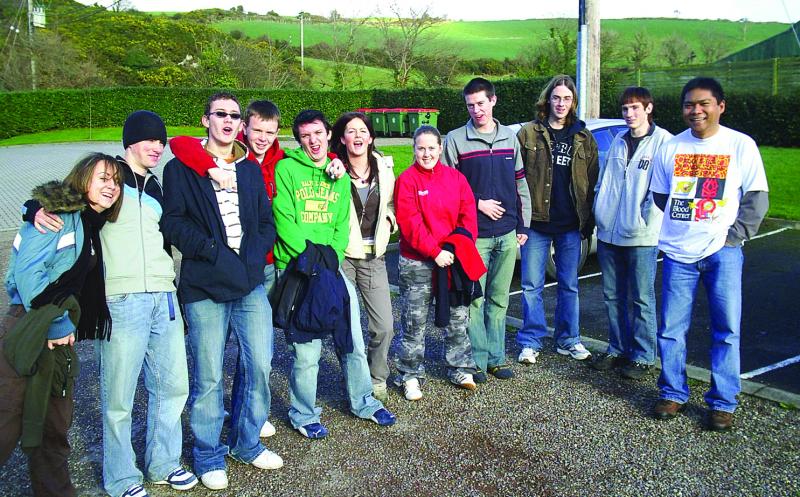
Joey Puerta, far right, with retreatants in Ireland
There’s some truth behind that famous quote of Forrest Gump’s momma, ‘Life is like a box of chocolates. You never know what you're gonna get.’ An unexpected shift in my career as an accountant came in November 2004 when the Redemptorists invited me to experience life as a Redemptorist volunteer lay co-worker in Ireland. I was to embark on a new journey in my life, opening a door that would lead me into a room filled with new meaning and discoveries. They told me I was very qualified for this mission and so with courage and a strong sense of faith, I travelled alone for almost 16 hours, leaving my loved ones behind in the Philippines. I eventually landed safely at my first destination in Ireland – Belfast.
Seen only in movies
I only knew Belfast, the capital of Northern Ireland, by reputation, reading and seeing in the movies what was happening there. It made me feel uneasy at first. Clonard Monastery, where the Redemptorists are based, is between the Catholic Falls Road area and the Protestant Shankill area. From the second floor window of the monastery, I could see the ‘peace wall’ which divides these communities, built to curb the tensions between them. For historical reasons, most Catholics want Northern Ireland to reunite with the Republic of Ireland, while most Protestants want it to remain in the United Kingdom. There was considerable violence in the area from 1969 until the 90s. It’s much more peaceful now compared to the early 80s when ‘The Troubles,’ as they were called, were at their peak.
Clonard is very active in ecumenical work and I had the opportunity to join in such activities involving the youth. I was also part of the Clonard Youth Ministry Team and most of my work was in facilitating retreats for different schools in Belfast and conducting parish youth missions across Northern Ireland.
Retreats with the youths
School retreats here in Ireland are a bit different from those back home. There I was used to weekend retreats while here they usually last only a day, starting around 9:30am and finishing at around 3:00pm. I was anxious at first since I came from a different country and most of the students were curious about my presence. But I was pleasantly surprised because they were actually looking forward to knowing me better. That eased my worries and I was able to settle in right away. My team facilitated school retreats four days a week but sometimes we conducted week-long parish youth missions out of town.
The work was quite challenging. Not only did I have to prepare the activities I wanted to use but also had to learn the local accent! Ask anybody who is new to Belfast and they will say that the accent is definitely ‘unique’. It was like my experience of learning Kinaray-a and Cebuano back in college! The students were also kind enough to teach me some local slang like ‘craic’ (‘crack’ – not the drug but lively conversation and funwhich the Irish are famous for) and some ‘interesting’ acronyms like IRA, UVF, UDA and UFF, (sounds like KFC or Jollibee!) [Editor’s note: these are the initials of various illegal armies in Northern Ireland, similar to the NPA and the MILF here.]
Largest Novena in Ireland
During my stay in Belfast, I had also the opportunity to experience the renowned Clonard Novena (www.clonard.com), celebrated every June for nine consecutive days. There are nine sessions every day and thousands upon thousands from all over Northern Ireland come and offer their prayers to our Mother of Perpetual Help. This, by far, is the largest novena in Ireland, second only to our famous Baclaran Novena. In this experience, I had the chance to meet many Filipinos, mostly nurses and carers, ardently attending this special celebration. Because there were so many devotees, I was asked to be a traffic marshal. I really enjoyed the experience since it was my first time to direct traffic and park cars!
After nine months of mission in Belfast, I was invited to help out with the Scala Youth Ministry Project (www.scala.ie) of the Redemptorists in Cork, located in the far south of Ireland. Cork has a number of the Catholic schools founded by Nano Nagle, foundress of the Presentation Sisters (www.iol.ie/~presnpro). The Presentation Sisters now run the Scala Retreat House of the Redemptorists in Bacolod City, where I’m from. Here in Scala, Cork, I’m part of the team that facilitates up to four school retreats per week for junior and senior high school students and I’m also involved with the Meitheal Programme, a youth leadership development program working with over 100 students in 16 different schools all over Cork. [Editor’s note: the Irish word ‘meitheal’ ‘MEHal,’means the same as ‘bayanihan.’]
Cork, like Belfast, is a very interesting place to be. Not only are the people very friendly and accommodating, but the accent here is as unique as that in Belfast. The people in both cities use the same words – more or less – but any resemblance to standard English is purely coincidental!
Something from a simple work
A Filipino missionary in Fiji wrote, ‘A missionary’s heart is one willing to share and to be shared.’ My journey here in Ireland has lasted more than a year so far, but I’ve discovered in my own small way that I’m able to share my time, treasure and talents. It’s a very inspiring realization that by doing a selfless act, and enjoying the experience of the moment, I’m able to reap such a bountiful reward, more valuable than financial success. There’s nothing extraordinary in my work as a facilitator. It’s just a matter of giving students an opportunity to spend a day with their friends and to be away from the pressures of family, school and exams. By offering them some interesting activities and a listening ear, I’m able to celebrate a day with them in which they’re able to enrich their relationships with others and at the same time give them the chance to discover their own spirituality.
Unforgettable Ireland
It's said that Ireland, once visited, is never forgotten. Truly, my mission here is an on-going journey in my life, an experience that I will always cherish in my heart. To have been raised by a loving family, to be part of a community, the Redemptorists, that provides a positive experience of God and to work in youth ministry, are just some of the many inspirations that keep me going everyday.
So is my life’s mission like Momma Gump’s ‘box of chocolates’? No, it’s more like the Ireland of Johnny Cash’s song, with ‘Forty Shades of Green,’ and none of them faded.
‘Memoriatón’ For Reconciliation In Peru
By Father Chris Baker SSC
The author, ordained in 1950, is one of three Australian brothers who are Columban priests. His elder brother, Father Leo, was ordained in 1948 and is now retired in Australia after many years in Japan. His younger brother Patrick, ordained in 1962, is based in OzamizCity and is coordinator of the Columban Associate Priests’ Program in the Philippines.
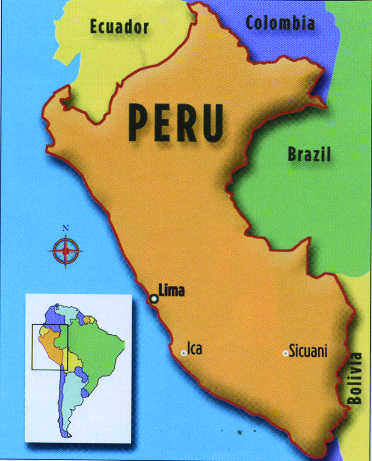
Map of PERU
Twenty years of Sendero Luminoso, ‘Shining Path,’ terrorism and its repression by the police and armed forces of Peru came to a halt in 2000. Shortly after the dismissal of President Alberto Fujimori that year, an interim and then democratically elected president, Alejandro Toledo, set up a Commission for Truth and Reconciliation. Twelve well qualified and respected citizens were commissioned to investigate in depth the years of internal armed conflict from 1980 to 2000. Peruvians needed to know the full truth about the causes and consequences of the conflict in order to embark on the path to reconciliation. During two years of tireless field work, the commissioners, with the aid of 500 collaborators, interviewed some 17,000 victims of those violent years. Their findings were expertly analyzed and coordinated to show the date, place and results of each attack by armed groups causing death or destruction.
Deaths in 20 years
In August 2003 the Commission presented its Final Report to President Toledo. The nation was shocked to find out that an estimated 69,280 people had been killed during those 20 years. Eighty-five percent of those killed were humble country people, and 75 percent spoke Quechua or other indigenous languages rather than Spanish. Of the deaths reported to the Commission, 55 percent were inflicted by Shining Path militants, while the armed forces and police were responsible for 35 percent. The Commission pinpointed the conditions which gave rise to the armed conflict, and made many excellent recommendations to remedy the enormous damage done to mostly innocent people. It also insisted on sweeping reforms of the State authorities and armed forces to prevent the same tragedy being repeated in the future.
Let the people remember
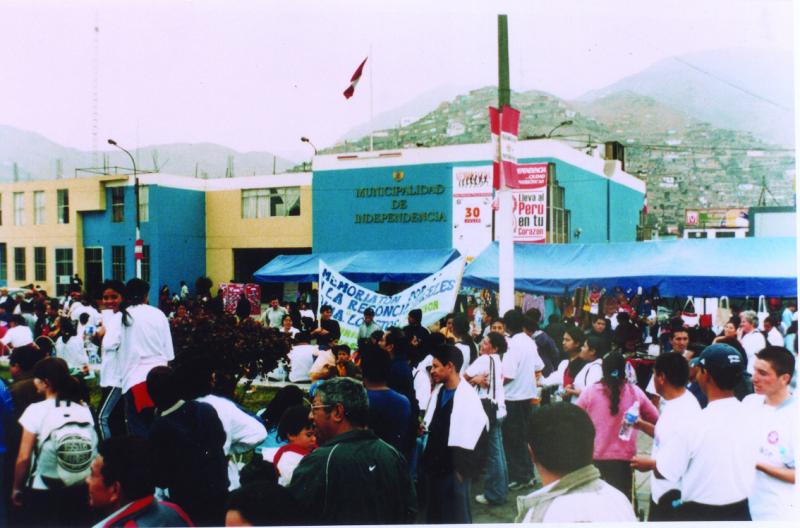
PERU CROWD
Instead of galvanizing the present government into implementing those recommendations, the Final Report has been badly neglected by most of the politicians and military. On the other hand, many Peruvian groups are doing their best to ensure that the Report not be buried and ignored in practice. This is what inspired social justice officers of the Diocese of Carabayllo and Columban missionaries to collaborate in organizing a ‘Memoriatón’ on Saturday 30 July 2005. The title compresses the Spanish forms of ‘memory’ and ‘marathon,’ because what we planned was a short marathon in the morning, leading the participants to a festival of memory in the afternoon. We had a commission working on the details for three months so that the marathon and the festival would arouse plenty of public participation.
Successful festival
The mini-marathon (8 kms) was so well attended that we had handed out all the 500 specially printed T-shirts to starters, and another 100 or more kept lining up. They had to set off without T-shirt or free bottle of water, as we had not expected so many starters. (We tried to make amends after the marathon by giving them a copy of the 20-page booklet produced by the commission, To Share the Memory in order to Reconstruct our Country, a popular summary of the 500-page Final Report.)
Police patrol cars and motorcycles had been sent to protect the joggers and walkers as they set off on a normally very busy avenue leading away from Lima’s international airport and crossing several other busy roads. Two of our priests in training for full marathons, Columban Father Tony Coney from Belfast and Fr Michael McKinnon, a Columban Associate Priest from the Diocese of Ballarat, Australia, led and kept the front group together, while Fr Peter Doyle, an Australian Columban, and I followed by car near the police vehicles. When they left we brought up the rear of the field, behind the ambulance with its doctor and nurse from Sister Millie McNamara’s Mercy Clinic. Fortunately, only a mother and a couple of children needed first aid and a free ride. All the others reached the finishing line at the Municipal Offices of Independencia, where the local Mayor, Yuri Vilela, had kindly offered us all facilities for the festival of memory.’
The mayor himself was there to greet the marathon joggers/walkers, as well as many other interested people who joined them in the municipal square. Likewise Bishop Lino Panizza of Carabayllo spoke of the need to keep alive the memory and lessons of those twenty most deadly years in all of Peru’s history since independence. Other speakers linked our short marathon with the long marathon of 2,200 kilometers then being jogged and walked by four ‘chasquis.’ They were following the old Inca road from Piura to Puno, in the footsteps of the legendary Inca chasquis, running couriers who carried official messages in the form of quipus,cords with a varying arrangement of knots.
The four modern ‘chasquis,’ including two youths orphaned by the conflict, were volunteers who wanted to collect quipus from representatives of every city, town and hamlet along their route. That old Inca road took them from top to bottom of Peru, through and over towering Andes mountains. It was chosen because it passes through practically all the areas where the vast majority of victims came from. This time each knot was to represent a person killed or otherwise damaged by the armed conflict in that area. At the end of their marathon, the four modern couriers were to bring all those quipus to the newly designated Memorial Grove near the middle of Lima. There they are to be enshrined permanently, surrounded by 69,280 stones, each bearing the name of a person killed.
Step to reconciliation
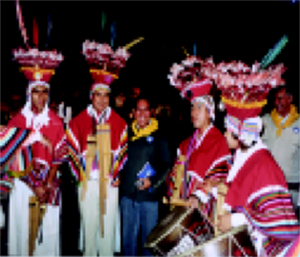
PERU GROUP
During the afternoon of our Memoriathon, a Peruvian Columban priest who writes and records his own songs, Father Diego Cabrera (www.padrediego.com), coordinated several good bands that came along. A highlight was the singing of an internationally acclaimed singer, Martina Portocarrero. She voluntarily sang many moving Peruvian songs and explained their importance for our theme. The audience also went into a municipal hall to see appropriate movies and photos. Everybody was encouraged to make a large quipu to be added to those carried in by the four hardy couriers. In that way the message from the departments which suffered most would be joined to that of Lima. The message expressed symbolically was that the blood of nearly 70,000 killed by their brothers would continue to cry out loudly from the earth until all their fellow Peruvians entered into a dialogue of reconciliation and make amends for any unjust damage inflicted on others. We feel that such solidarity in the creation of a huge national Quipu is already an important step along the road to national reconciliation.
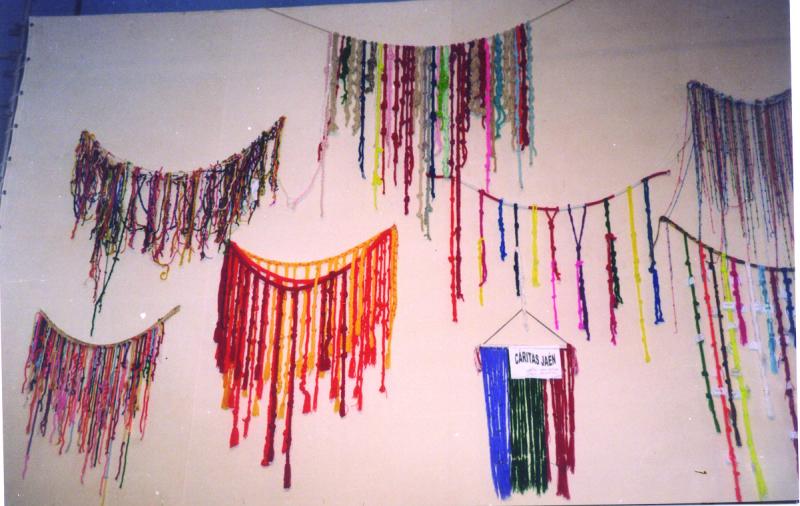
PERU Quipu
By a striking coincidence, shortly before our Memoriatón archeologists announced that they had unearthed a well preserved quipu, which they estimated to be about 3,000 years old! They found it while excavating Caral, Peru’s most ancient city. It indicates how deeply the quipu is embedded in Peruvian culture.
Less than a month after our Memoriathon we joined in a rousing welcome given by many thousands of people to those four remarkable ‘chasquis’ as they entered the Memorial Grove in Lima. They were fresh from finishing their 2,200 kms in Puno the previous day, but were looking fit. They spoke eloquently and confirmed for us that the main message heard all along their route was justice, reconciliation and reparation for the damage done.